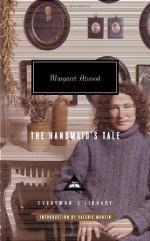|
|
The Handmaid's Tale Part 16: Historical Notes
This section is a parody of academic discussion. It is a partial transcript of a symposium on Gileadean Studies given in the year 2195. Professor Cresent Moon introduces the speaker, Professor Pieixoto. He is well know for his study "Iran and Gilead: Two Late-Twentieth-Century Monotheocracies, as Seen Through Diaries." The title of his talk is "Problems of Authentication in Reference to The Handmaid's Tale." After a few esoteric jokes, Pieixoto tells the audience that the tale, which came in the form of thirty cassette tapes, was discovered in Maine in a sealed army footlocker near what used to be the Underground Femaleroad. It was titled The Handmaid's Tale at a later date. Each tape began with music to disguise the nature of the diary, but the bulk of the tape recorded a woman's voice. Pieixoto and his colleague transcribed the tapes to the best of their ability. He suggests that it is unlikely that the tapes are forged. He also suggests that as historians they must not censor the Gileadean society but try to understand it.
The professor then goes into detail about how he attempted to discover the identity of the narrator and more information to back up her account. He explains the history behind the role of the Handmaid. The regime of Gilead declared all second marriages and non-marital liaisons adulterous and arrested all the females involved in such relationships. The fertile females among this group were doled out to the elite and childless. This occurred during an era of rapidly declining birthrates among Caucasians worldwide. The declining birthrate may have been caused by pollution as well as birth control. Claiming Biblical precedent, Gilead "replaced the serial polygamy common in the pre-Gilead period with the older form of simultaneous polygamy practiced in the Old Testament times." Chapter 47, pg. 305 Pieixoto notes that Gilead incorporated polygamous and racist practices of the society that preceded it into its tenants. He continues to explain the difficulty of authenticating the Tale. The narrator's name does not appear in the text. Official records of her existence would have been destroyed upon her entry into the Rachel and Leah Re-education Center. The rest of the names in the account were likely to be false for the purpose of protecting the people involved.
Pieixoto and his colleagues considered two possible men who may have been Offred's Commander. Both were instrumental in the formation of The Republic of Gilead. The evidence they found pointed to the man called Waterford, who had a former television personality as a wife and who was purged shortly after the time Offred would have escaped. He had an extensive collection of heretical materials, and was housing a subversive. Pieixoto guesses that Nick could be this person as the diary implies that Nick belonged to the quasi-military group called the Maydays who could have helped Offred escape. This is the extent of what they can guess with reasonable accuracy. Pieixoto can only speculate about the ultimate fate of the narrator and her characters. She may have escaped to Canada and then England. Nick had her rescued by the Eyes, who he undoubtedly belonged to, but it may have capitulated his own downfall. Pieixoto confesses that he can only summon forth echoes from the past. He claims this is the nature of history. The audience applauds.



